Has a problem been found?

Repair as necessary and go to "Verification of Vehicle Repair" procedure.

Go to "Signal Circuit Inspection" procedure.
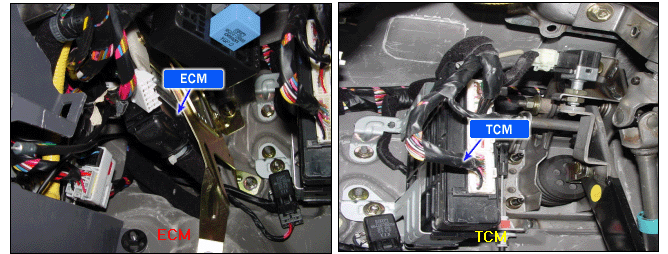
The ECM communicates over the CAN with the EMS(Engine Management System), TCS(Traction Control System) and
TCM(Transmission Control Moudle). Through CAN, only two Lines are required to achieve the same function. The information is in digital format . This method does not use a integrated ECM.
Input signals to TCM through "CAN communication" are as follows.
▶ Engine rpm, TPS signal, A/C signal, WTS signal, AFS signal, Vss signal, Shift holding signal (FTCS ON) Output signals from TCM through "CAN communication" are as follows.
▶ Request signal for torque reduction, ATF temperature, TCM type, TCM error or not, damper clutch on, off/gear position.
In case of the CAN failure, the engine symptoms will occur the corrupted torque reduction signal information, shift shock and increasing engine rpm abruptly.
If the CAN communication is generated threshold value, the ECM judged this as a fault and DTC is set.
Item | Detecting Condition | Possible Cause |
DTC Strategy | ● Signal check, high and low | ● Open in signal circuit ● Short to ground in signal circuit ● Faulty TCM ● Faulty ECM |
Enable Conditions | ● Ignition on | |
Threshold Value | ● Error between ECM and TCM communication. | |
Diagnostic Time | ● 1 sec. | |
MIL Fuel Limit Fuel Cut EGR Off | ● No ● No ● No ● No |
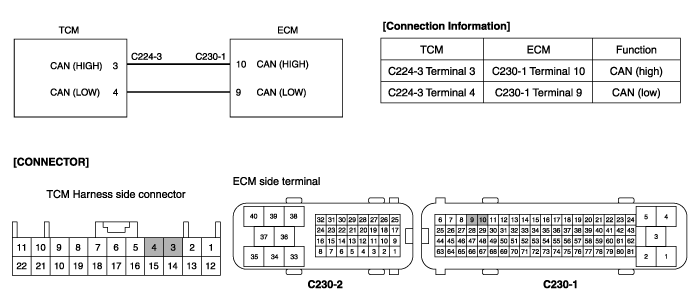

Many malfunctions in the electrical system are caused by poor harness and terminals.
Faults can also be caused by interference from other electrical systems, and mechanical or chemical damage.
Thoroughly check connectors for looseness, poor connection, bending, corrosion, contamination, deterioration, or damage.
Has a problem been found?

Repair as necessary and go to "Verification of Vehicle Repair" procedure.

Go to "Signal Circuit Inspection" procedure.
Check for open in harness
Ignition "OFF" & Engine "OFF".
Disconnect ECM & TCM connector.
Measure resistance between terminal 4 of TCM harness connector and terminal 9 of ECM harness connector.
Measure resistance between terminal 3 of TCM harness connector and terminal 10 of ECM harness connector.
Specification : Approx. below 1Ω
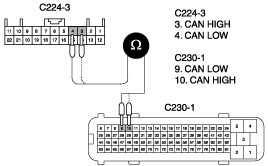
Is the measured resistance within specifications ?

▶ Go to "Check for short to ground in harness" as below.

▶ Check for open in the signal harness.
Repair as necessary and go to "Verification of Vehicle Repair" procedure.
Check for short to ground in harness.
Ignition "OFF" & Engine "OFF".
Disconnect TCM,ECM, TCCU and HCU connector.
Measure resistance between terminal 4 of TCM harness connector and chassis ground.
Measure resistance between terminal 3 of TCM harness connector and chassis ground.
Specification : Approx. 5V
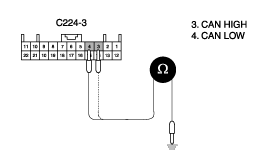
Is the measured resistance within specificaitons ?

▶ Go to "Component Inspection" procedure.

▶ Check for short to ground in signal harness.
Repair as necessary and go to "Verification of Vehicle Repair" procedure.
Check resistance
Ignition "OFF" & Engine "OFF".
Disconnect TCM connector.
Measure resistance between terminal 3 and 4 of TCM harness connector.
Not TCS, 4WD | TCS, 4WD | ||
ECM & TCM connected | ECM connected only | TCM connected only | ECM & TCM connected |
60Ω ± 1Ω | 120Ω ± 2Ω | 120Ω ± 2Ω | 120Ω ± 2Ω |
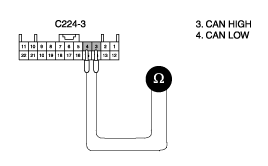
Is the measured resistance within specifications ?

▶ Go to "Check signal waveform" as below.

▶ Substitute with a known-good ECM and check for proper operation.
If the problem is corrected, replace ECM and then go to "Verification of Vehicle Repair" procedure.
Check signal waveform
Ignition "OFF" & Engine "OFF".
Disconnect ECM connector.
Monitor signal waveform at terminal 3 and 4 of TCM connector simultaneously.

Are CAN signals generated correctly ?

▶ Thoroughly check connectors for looseness, poor connection,bending, corrosion, contamination, deterioration, or damage. Repair or replace as necessary and then go to "Verification of Vehicle Repair" procedure.

▶ Substitute with a known-good ECM and check for proper operation.
If the problem is corrected, replace ECM and then go to "Verification of Vehicle Repair" procedure.
After a repair, it is essential to verify that the fault has been corrected.
Connect scan tool and select "Diagnostic Trouble Codes(DTCs)" mode and then clear DTC.
Operate the vehicle within DTC Enable conditions in General information.
Are any DTCs present ?

Go to the applicable troubleshooting procedure.

System is performing to specification at this time.